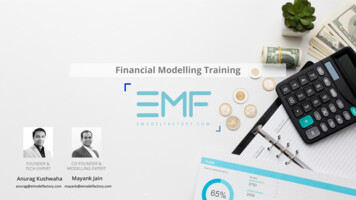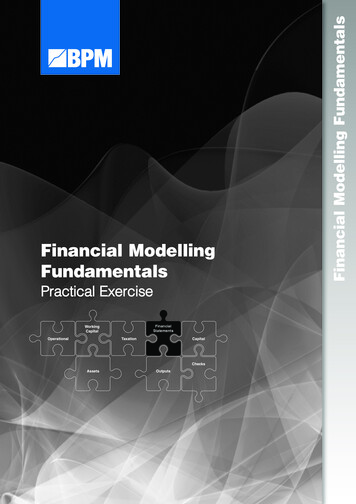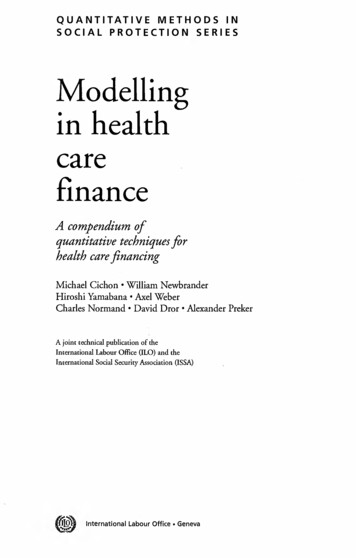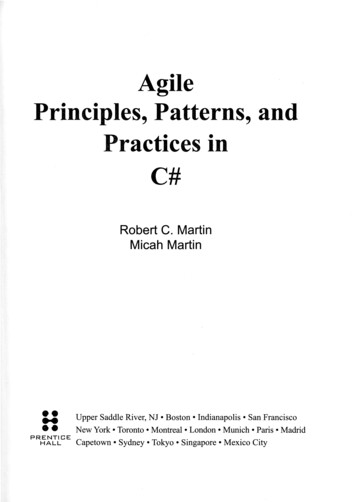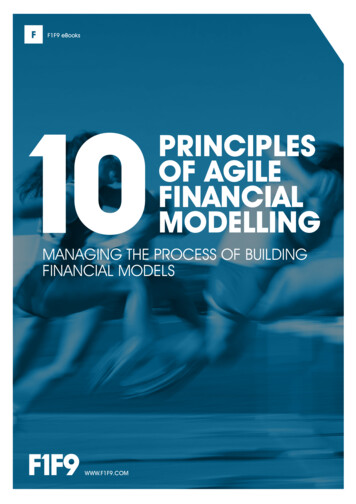
Transcription
F1F9 eBooksPRINCIPLESOF AGILEFINANCIALMODELLINGMANAGING THE PROCESS OF BUILDINGFINANCIAL MODELSWWW.F1F9.COM
“ Read a 20 page ebook?You have to be kidding!I want the key points in 30 seconds. ”SHARE THIS eBOOK
AGILE FINANCIALMODELLINGIN 30 SECONDSBuilding financial models is an inherently difficult and complex task.Most guidance on managing the model build process recommends atraditional life-cycle approach of Specify, Design, Develop, Test, Deploy.When applied to most financial modelling assignments this approachdoesn’t work.It is too inflexible and relies on being able to fully specify the model at thebeginning, which is rarely the case.Software developers realised this a while back and developed an a morecollaborative and iterative methodology called AgileThe Agile Manifesto states a preference for individuals and interactionsover processes and tools; working software over comprehensivedocumentation; customer collaboration over contract negotiation;responding to change over following a planAgile approaches also work for financial modelling. This isn’t a surprisebecause financial modelling is a lot like software development.Agile is about short, strictly time limited, iterative development cyclescalled “Sprints”.Agile relies on shared standards and modular code.This will make it a challenge for many modelling firms to implement.This makes it a perfect fit for firms who have adopted FAST.SHARE THIS eBOOK
IS THIS BOOKRIGHT FOR ME?NOT SURE IF THIS EBOOK IS QUITE RIGHT FOR YOU?SEE IF WHAT YOU ARE ABOUT TO READ MATCHES YOUR REQUIREMENTSTHISGUIDEFAST FINANCIAL MODELLINGFUseful, practical information about FAST financial modelling, managingmodelling projects and good modelling practice.BAPFBANKING & ADVISORYTargeted at, but not exclusive to, banking and advisory practice areas,exploring modelling topics like credit analysis, debt structuring etc.PROJECT FINANCEFocussing on the kind of transactional modelling typically associated withthe development of infrastructure, PFI and PPP projects.ENTERPRISE REPORTING & ANALYSISEUseful information and practical guidance on the apllication of modellingdiscipline and standards to improve business decision making.ENENERGY & NATURAL RESOURCESInsight and practical guidance on the aplication of good modelling practicespecifically related to these often complicated business areas.FFAST FINANCIALMODELLINGBA BANKING& ADVISORYEENTERPRISEREPORTING & ANALYSIS&EN ENERGYNATURAL RESOURCESPF PROJECTFINANCE
5WWW.F1F9.COMContents3AGILE FINANCIAL MODELLINGIN 30 SECONDS4IS THIS BOOK RIGHT FOR ME?8ABOUT THE AUTHOR9A PERSONAL INTRODUCTION10F1F9 & AGILE11THE PROBLEM WITH TRADITIONALPROJECT MANAGEMENT.14WHAT IS AGILE?16APPLYING AGILE TO FINANCIALMODELLING17THE 10 PRINCIPLES OFAGILE FINANCIAL MODELLING19GOING DEEPERSHARE THIS eBOOK
WWW.F1F9.COMlike Dacia cars inCommunist Romania itseems that the value offinancial models goesup the older they are,the reasoning being“If it’s lasted this long,it must be a good one.”SHARE THIS eBOOK6
10 PRINCIPLESOF AGILE FINANCIALMODELLINGMANAGING THEPROCESS OF BUILDINGFINANCIAL MODELS
FABOUT F1F9F1F9 provides financial modelling and business forecasting support to bluechip clients and medium-sized corporates. We also teach financial modellingskills to companies around the world. Our clients have access to high quality,low-cost modelling support delivered by 40 professional modellers.F1F9 co-developed the FAST Standard that allows modellers and non-modellersto work together and understand financial models. Transparency is the corevalue that drives our modelling and our business activities.ABOUT THE AUTHORKenny Whitelaw-Jones is a modelling instructor at F1F9. He worked withsome horrific financial models early in his career and vowed to save othersfrom the same fate by teaching them modelling techniques that actuallywork. That’s why he’s passionate about raising standards in modelling. Whenhe’s not doing that he’s usually driving one of his four children to a socialengagement. He enjoys sailing and writing about himself in the third person.Kenny is currently working on the first crowd-sourced “Financial ModellingHandbook” based on the FAST standard. Please join in.www.financialmodellinghandbook.com
A PERSONAL INTRODUCTIONPicture the scene. It’s 2001. It’s just past 1am in the London headoffice of a FTSE-250 industrial conglomerate. I’m sitting in the BoardRoom with the Finance Director and my boss, a Partner from a Big 4Accounting firm.I’ve been with the firm for less than 2 months. I’ve been on this assignment for 11 hours. I’mvery keen to make a good impression. The client company is in trouble and they’ve brought inadvisors to help get them out of it. They have days before they run out of cash. They have torestructrure their financing to be able to survive. The meetings with their bankers are hours away.Both men are looking at me. They want to know why the working capital numbers from themodel don’t make any sense. I want more than anything to be able to tell them.But I can’t. I can’t because I haven’t looked at the working capital section of the model. Ever.It’s humiliating not to have the answers they are looking for.I had been assigned to the team earlier in the day to help the lead modeller. He had just comeback from an assignment to restructure a major European Airline. The model which had beenused for the successful airline restructuring was being used for this one. I learned later that,like Dacia cars in Communist Romania it seems that the value of financial models goes up theolder they are, the reasoning being “If it’s lasted this long, it must be a good one”.He was already exhausted having worked for months on the airline restructuring. At 10pm thatnight he cracked under the pressure. Critically, he hadn’t built the original airline restructuringmodel but had done a good job of using it during that transaction. He was now struggling toadapt it for this assignment and had been working under increasing pressure. And neither thesenior people from our firm, nor the client could understand why it was all taking so long.The person who had built the original model was on another assignment, in another time zone,and wasn’t available to help.In short, nobody understood the model, least of all me.The Finance Director was, quite rightly, running out of patience. I would love to say that in the yearssince then I haven’t seen this story repeated. But I have. Often. And it’s completely unnecessary.If the model had been built to a common standard, everybody would have understood it.If the model had been built using the FAST standard, it would have been much easier to changeit, and a working model would have been delivered much earlier in the process, giving more timefor the Partner to look at the numbers and recommend a course of action.If the Partner in charge of the assignment had understood the difference between Conceptualmodelling and spreadsheet engineering the communication with the modellers would haveworked much better.If some practical project management structures had been put in place, the whole assignmentwould have been under control.None of that happened.I’ve spent my whole career since then involved with financial models and I now teach modellingfor a living. My purpose is to liberate financial modellers from this kind of abuse caused by poormanagement practices.SHARE THIS eBOOK
WWW.F1F9.COMF1F9 AND AgileAt F1F9 we have been applying the principles ofAgile for years. We just haven’t been calling it that.Our approach to managing modelling assignments emerged through years of trial and error.It just so happens that Agile was developing in parallel in the software industry. When weread about Agile we realised that it did the best job we’d come across of describing what wealready do and have found to be effective.That said, lots of the terminology and concepts common in Agile weren’t being used at F1F9.We are learning all the time as we implement these things in our own business modelling.This book therefore is the first, and not the last word on the subject. As we learn more we willshare more. While this guide introduces you to the principles of Agile and how they apply infinancial modelling, it is not a detailed guide on how to implement these practices in your business.That guide is coming next and we’ll let you know when it’s ready.SHARE THIS eBOOK10
11WWW.F1F9.COMTraditional projectmanagement approachesdon’t work when appliedto financial modellingBuilding financial models for clients, including “internal clients”, is an inherently difficult andcomplex task. Much guidance has been written on how to approach the challenge of managinga model build assignment. I try to read as much of it as I can get my hands on. As I’ve taughtFAST financial modelling to clients around the world, I’ve also been lucky enough to haveearned sufficient trust to be given access to internal company guides on financial modelling“best practice”.Many of the published books, and most of the internal guides, have a section on “managingmodelling assignments” that goes something a little like TATIONTraditional project management approaches to financial modelling don’t always work. In factthey work so rarely that we may as well say that they don’t work at all.In my experience, nobody actually truly applies traditional management approaches to managing modelling assignments. Modellers don’t apply these approaches in practice because theydon’t work. They are almost impossible to implement.They work really well in theory.(which is something at least.)SHARE THIS eBOOK
12WWW.F1F9.COMWhy traditionalapproachesto projectmanagement don’twork for modelling“The great strength ofthis approach is that itis logical. “The traditional “best practice” way to build financialmodels was a sequential life cycle of which there aremany variants. In other areas, such as software development, this approach is commonly known as “TheWaterfall”. I shall refer to it as “The Waterfall” for the restof this book; “The Traditional Approach to Project Management in Financial Modelling” is much less snappy.The waterfall method typically begins with a detailed planning phase, where the endproduct is carefully thought through, designed, and documented in great detail.Once project stakeholders have thoroughly reviewed and signed off on the designand specification the team can get to work.Once the work is complete, it is ready to go into the “testing phase”, often called“Quality Assurance”. Once testing is complete the finished item can be shipped tothe customer.Throughout the process, strict controls are placed on deviations from the plan toensure that what is produced is actually what was designed.The great strength of this approach is that it is logical.It makes absolute sense to think before you build, write it all down, follow a plan, andkeep everything as organised as possible. Who could argue with that? It has however,one enormous and under-recognised weakness: humans are involved.And human involvement causes lots of problems.“the model is usually atesting environmentfor business hypotheses”1. We are really bad at predicting the future. Well, you might notbe, but I definitely am.Even though the broad direction of travel of an assignment is usually known fromthe start (e.g. model this FTSE-250 industrial conglomerate), the precise requirementsof a model usually unfold in parallel with the model’s development. After all, themodel is usually a testing environment for business hypotheses and these businesshypotheses evolve over time, often rapidly.Similarly, it’s often only when clients get their hands on a working model that the “ahamoments” occur. It’s at this point that the client thinks of 20 ways they could makethe model better. Unfortunately, these critical insights come at the end of the modeldevelopment cycle when it is most expensive to include them.Recently we’ve been helping a client with a model for a Social Impact Bond project.The project is in early stage development. Every time they have discussions with project stakeholders and potential investors their hypothesis about the project changes
WWW.F1F9.COM13slightly. If we tried to write a detailed specification from the start it would have been a detailed work offiction and an enormous waste of time. This is an extreme example because this is a “pathfinder project”– but even in stable, mature sectors like Project Finance, each project is different, and the unexpectedalways happens. And by its very nature the unexpected didn’t make it into the specification.A rigid, change-resistant process often produces mediocre results. While clients may get what they firstasked for, is it what they really want once they see and use the model? The waterfall approach means thefinished model is only as good as the initial idea.“No.”, I hear you say. “I work for a [Large Prestigious Consulting Company] and this has never happenedto us.” While that may be true, it may also be that your clients haven’t told you about it. They couldn’tget the change they wanted after the event because it would be too expensive. So they “made do”, orthey went elsewhere. And judging by the number of requests that we get to rebuild unusable models tothe FAST standard, this happens rather often.2. Written documents have their limitationsThe first being that they generally don’t get read. (With the exception of this one of course).If you’re like me you’re probably skim reading this looking for the key messages (that’s why weput a key messages section up front – to save you the hassle).Long detailed specification documents don’t get read. Not ever. Those of you who like processand detail may wish for that statement not to be true, but to quote John Henry Newman,“We cannot make facts. All our wishing cannot change them. We must use them.”Jeff Sutherland pioneered the Agile methods in the software development arena. He describedthe reliance on written documentation as follows:“The waterfall approach to project management places a great emphasis on writing thingsdown as a primary method for communicating critical information. The very reasonableassumption is that if I can write down on paper as much as possible of what’s in my head, it willmore reliably make it into the head of everyone else on the team; plus, if it’s on paper, there istangible proof that I’ve done my job. When they do get read, the misunderstandings are oftencompounded. A written document is an incomplete picture of my ideas; when you read it, youcreate another abstraction, which is now two steps away from what I think I meant to say at thattime. It is no surprise that serious misunderstandings occur.”ℹAt F1F9, we have found that the best way to reach a sharedunderstanding of what is required in a model is in a discussion.A face to face discussion is best but as our modellers are in Delhi,that’s not always possible. We will often follow the discussion upwith a pictorial or written representation of what we’ve understood,but the understanding emerges best in conversation.
WWW.F1F9.COM14What is Agile?HISTORYAgile can trace its roots back to a meeting in Utah in 2001; 17 software developers who met to discussdevelopment methods.They published the Manifesto for Agile Software Development http://agilemanifesto.org/THE AGILE MANIFESTOWe are uncovering better ways of developing software by doing it and helping others do it.Through this work we have come to value:Individuals and interactions over processes and toolsℹWorking software over comprehensive documentationCustomer collaboration over contract negotiationResponding to change over following a planThat is, while there is value in the items on the right, we value the items on the left moreTHE 12 PRINCIPLES OF AGILE DEVELOPMENTOur highest priority is to satisfy the customer through early andcontinuous delivery of valuable software.12Welcome changing requirements, even late in development.Agile processes harness change for the customer’s competitiveadvantage.Deliver working software frequently, from a couple of weeks toa couple of months, with a preference to the shorter timescale.Business people and developers must work together dailythroughout the project.
WWW.F1F9.COMTHE 12 PRINCIPLES OF AGILE DEVELOPMENTBuild projects around motivated individuals. Give them theenvironment and support they need, and trust them to getthe job done.The most efficient and effective method of conveyinginformation to and within a development team is face-to-faceconversation.Working software is the primary measure of progress.Agile processes promote sustainable development. Thesponsors, developers, and users should be able to maintain aconstant pace indefinitely.12Continuous attention to technical excellence and good designenhances agility.Simplicity—the art of maximising the amount of work notdone—is essential.The best architectures, requirements, and designs emerge fromself-organising teams.At regular intervals, the team reflects on how to become moreeffective, then tunes and adjusts its behaviour accordingly.15
WWW.F1F9.COMApplyingAgile tofinancialmodellingThe Agile Manifesto and the 12 Principles of AgileDevelopment do a great job of describing how wealready approach model building at F1F9.However, while financial modelling can learn from software development,the two industries are not the same. For example, it’s taken for grantedin software development that coders working together will be using the same“language”. While the FAST Standard describes itself metaphorically as a sharedlanguage for modellers, it is really a shared approach to structure and layoutwhich is different.At F1F9 we have therefore adapted the ideas of the Agile Manifesto to theworld of financial modelling.SHARE THIS eBOOK16
17WWW.F1F9.COM10 principles ofAgile FinancialModellingOur model build approach is basedon standards rather than individualpreferencesStandards, and in our case the FAST Standard, provide the framework formodel design and construction that enables an Agile approach to financialmodelling.We encourage split roles ratherthan one person expected to doeverything.The person with the commercial / conceptual understanding does not haveto be, and often should not be the same person as the person doing themodelling (the ‘spreadsheet engineer’). The conceptual modeller has thevision for the “end state” of the financial model and knows its purposeand how it will be used. The spreadsheet engineer builds the spreadsheet.The team members with the commercial insights are typically more seniorand therefore more expensive than the spreadsheet engineers, so splitrole modelling provides the best allocation of resources. It also serves toreduce risk by increasing the number of people looking at the model.We apply rapid and regular iterationrather than single point delivery of afinished product.Rather than the traditional “waterfall” project management methodology(Specify, Design, Develop, Test, Implement, or some variation of thesesteps), model development is rapid and iterations are frequent. The shorterthe time frame between iterations the better. These iterations are sharedwith the “model owner” frequently during the build process and engenderregular conversations and changes of direction.We rely on collaborationThe commercial / conceptual “owner” of the model must work togetherwith the spreadsheet engineers daily throughout the project. We often findthat new clients start out wanting everything specified and tied down ina contractual specification document – and end up in a partnership basedcollaborative working relationship. The starting position is based on the“waterfall” project management approach where the model is specifiedupfront in minute detail and then delivered some weeks or months later.This approach usually fails to produce what the client wants.We welcome changes to therequirements, even late in thedevelopment process.Waterfall project management presupposes that the requirement is staticand that the requirement is fully known at the outset. This is rarely thecase in the development of financial models. The rapid iteration and collaboration inherent in Agile Financial Modelling means that regular changesare an expected and welcome part of the process.SHARE THIS eBOOK
18WWW.F1F9.COMWe aim for maximum constructionefficiencyIn order to facilitate the rapid iterations that Agile Financial Modelling isbased on, the spreadsheet engineering team has to be highly efficient.This is achieved through:a. Standard construction processes. By doing things the same way eachtime, we increase productivity and reduce development time and error.Standard construction processes are enabled by standard model design.b. Modular construction and reusable code blocks. FAST models favoursextreme modularity in models. This allows the repeat use of code blocks,or modules. There are many code blocks that are common across models.c. Team development processes. Standardisation and model modularityallow multiple team members to work on the same model in parallel.Our models are self-documentingEverything needed to understand the model is in the model. We avoiddatabooks and user guides; they tend to be out of the date as soon as theyare built and are rarely useful.There is ongoing regular informalcommunication within the projectteamFace to face communication is best, followed by video calls, followed byaudio calls. Written communication such as email and instant messaging isuseful for status updates, but a poor collaboration medium.There is a relentless focus ontransparency and ease of use,which is best delivered by simplicitySimplicity allows models to be shared, understood, changed, adaptedand used.We pay continuous attention totechnical excellence and gooddesignDelivering simplicity in modelling is not the easy option. It requires hardwork and considerable investment of time.SHARE THIS eBOOK
WWW.F1F9.COM19Go deeperDISCUSSWe’d love to hear your feedback and reaction to the 10 principles of Agile Financial modelling.www.financialmodellinghandbook.comTo discuss this ebook please visit the Agile Financial Modelling page on the“Financial Modelling Handbook” websiteTo contribute to the conversation about the FAST Standard please join the FAST Standard Linked In group.READ MOREForbes Magazine: “The Best Kept Management Secret on the Planet: Agile”Forbes Magazine: “Scrum is major management discovery”Scrum.org “What is scrum”Wikipedia: “Agile software development”Agile Alliance: “The Agile Manifesto”Agile Alliance: “The Twelve Principles of Agile Software”Video link: Agile Conference presentation: Managing a collaborative multi-national team in real timeSHARE THIS eBOOK
20WWW.F1F9.COMcheck out our other ebooks.WHY FIXED PRICE CONTRACTSARE BAD FOR EVERYONES-CURVE (CAPEX) MODELLINGIN OIL & GASTHE DIRTY DOZEN:12 MODELLING HORROR STORIESOPEX MODELLINGIN OIL & GASTHE BUSINESSANALYSIS LIFECYCLEHOW TO STANDARDISE MODELLING:5 LESSONS LEARNED THE HARD WAYOIL & GASMODELLING CHECKLISTESSENTIALMODEL OPTIMISATIONCOPYRIGHTThis ebook is licensed under a Creative Commons Attribution-NoDerivs 3.0 Unported License.You areactively encouraged to copy, distribute and share this ebook provided that you provide proper attribution.
F1F9 eBooks.F1F9 builds and maintains financial models usedby leading corporates, advisors, banks and funds.We also train our clients to build better modelsthemselves through courses delivered worldwide.To discuss how our team can help you improveyour corporate modelling and forecasting callLynn Martin on 44 203 239 8575or email lynn.martin@f1f9.com20-22 Bedford Row,London WC1R 4JS 44 20 3322 2722www.f1f9.com
Building financial models is an inherently difficult and complex task. Most guidance on managing the model build process recommends a traditional life-cycle approach of Specify, Design, Develop, Test, Deploy. When applied to most
